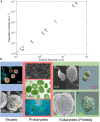Ocean Aerobiology
- PMID: 34777320
- PMCID: PMC8586456
- DOI: 10.3389/fmicb.2021.764178
Ocean Aerobiology
Abstract
Ocean aerobiology is defined here as the study of biological particles of marine origin, including living organisms, present in the atmosphere and their role in ecological, biogeochemical, and climate processes. Hundreds of trillions of microorganisms are exchanged between ocean and atmosphere daily. Within a few days, tropospheric transport potentially disperses microorganisms over continents and between oceans. There is a need to better identify and quantify marine aerobiota, characterize the time spans and distances of marine microorganisms' atmospheric transport, and determine whether microorganisms acclimate to atmospheric conditions and remain viable, or even grow. Exploring the atmosphere as a microbial habitat is fundamental for understanding the consequences of dispersal and will expand our knowledge of biodiversity, biogeography, and ecosystem connectivity across different marine environments. Marine organic matter is chemically transformed in the atmosphere, including remineralization back to CO2. The magnitude of these transformations is insignificant in the context of the annual marine carbon cycle, but may be a significant sink for marine recalcitrant organic matter over long (∼104 years) timescales. In addition, organic matter in sea spray aerosol plays a significant role in the Earth's radiative budget by scattering solar radiation, and indirectly by affecting cloud properties. Marine organic matter is generally a poor source of cloud condensation nuclei (CCN), but a significant source of ice nucleating particles (INPs), affecting the formation of mixed-phase and ice clouds. This review will show that marine biogenic aerosol plays an impactful, but poorly constrained, role in marine ecosystems, biogeochemical processes, and the Earth's climate system. Further work is needed to characterize the connectivity and feedbacks between the atmosphere and ocean ecosystems in order to integrate this complexity into Earth System models, facilitating future climate and biogeochemical predictions.
Keywords: aerobiota; air-sea interaction; atmospheric dispersal; biogenic aerosol; cloud condensation nuclei (CCN); ice nucleating particles (INPs); microbial oceanography; sea spray aerosol (SSA).
Copyright © 2021 Alsante, Thornton and Brooks.
Conflict of interest statement
The authors declare that the research was conducted in the absence of any commercial or financial relationships that could be construed as a potential conflict of interest.
Figures





References
-
- Ahern H. E., Walsh K. A., Hill T. C. J., Moffett B. F. (2007). Ice-nucleation negative fluorescent pseudomonads isolated from Hebridean cloud and rain water produce biosurfactants. Biogeosciences 4 115–124. 10.5194/bg-4-115-2007 - DOI
-
- Alldredge A. L., Passow U., Logan B. E. (1993). The abundance and significance of a class of large, transparent organic particles in the ocean. Deep Sea Res. I 40 1131–1140. 10.1016/0967-0637(93)90129-Q - DOI
-
- Aller J. Y., Kuznetsova M. R., Jahns C. J., Kemp P. F. (2005). The sea surface microlayer as a source of viral and bacterial enrichment in marine aerosols. J. Aerosol Sci. 36 801–812. 10.1016/j.jaerosci.2004.10.012 - DOI
-
- Aller J. Y., Radway J. C., Kilthau W. P., Bothe D. W., Wilson T. W., Vaillancourt R. D., et al. (2017). Size-resolved characterization of the polysaccharidic and proteinaceous components of sea spray aerosol. Atmos. Environ. 154 331–347. 10.1016/j.atmosenv.2017.01.053 - DOI
Publication types
LinkOut - more resources
Full Text Sources
Research Materials

